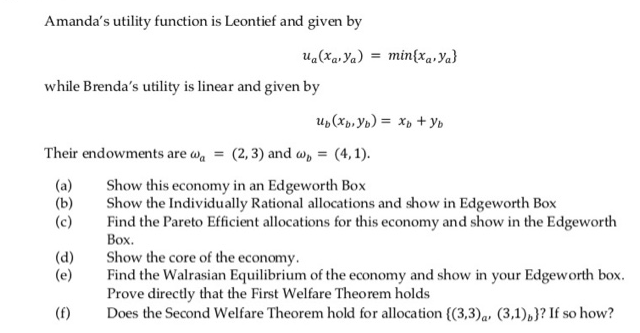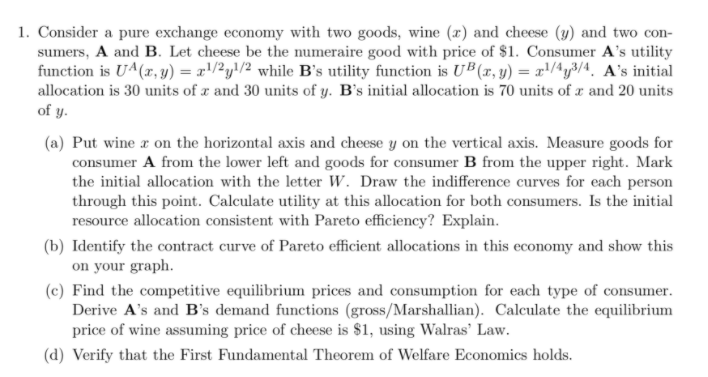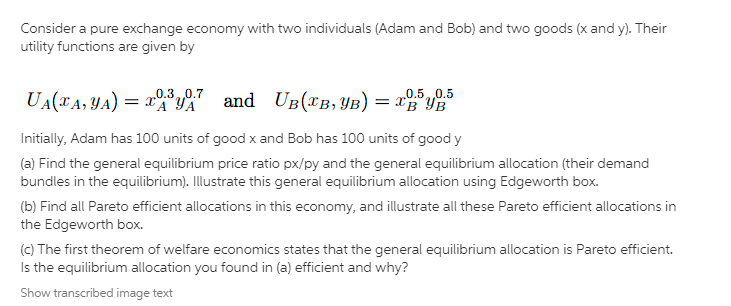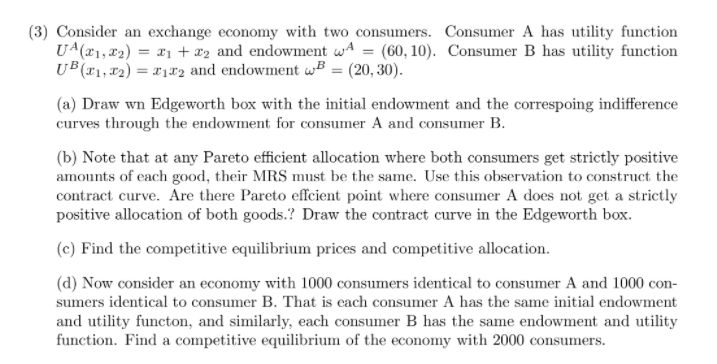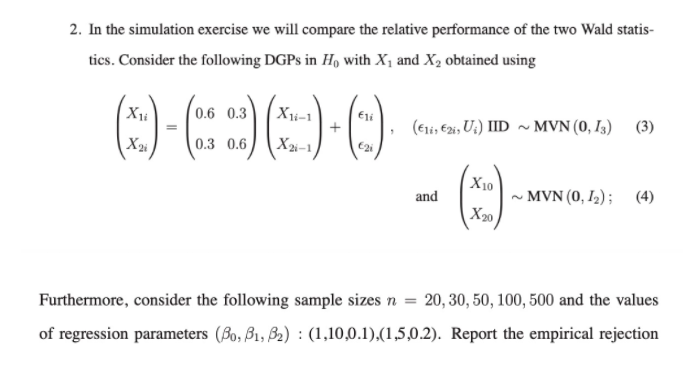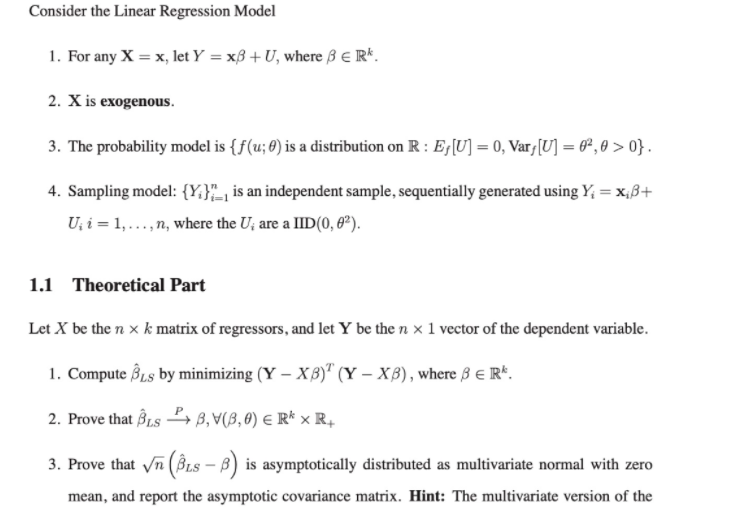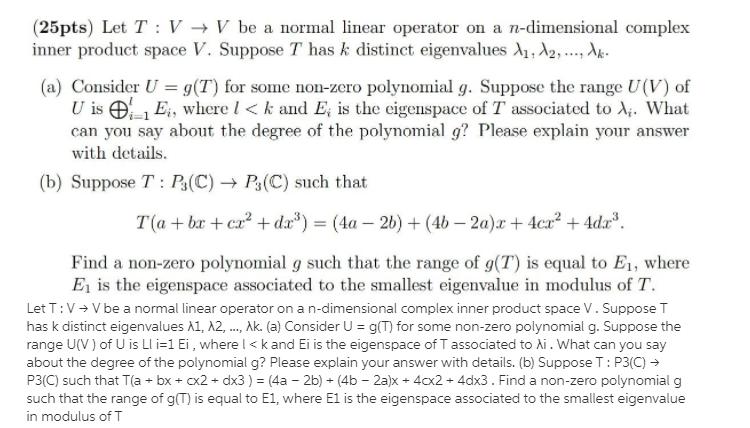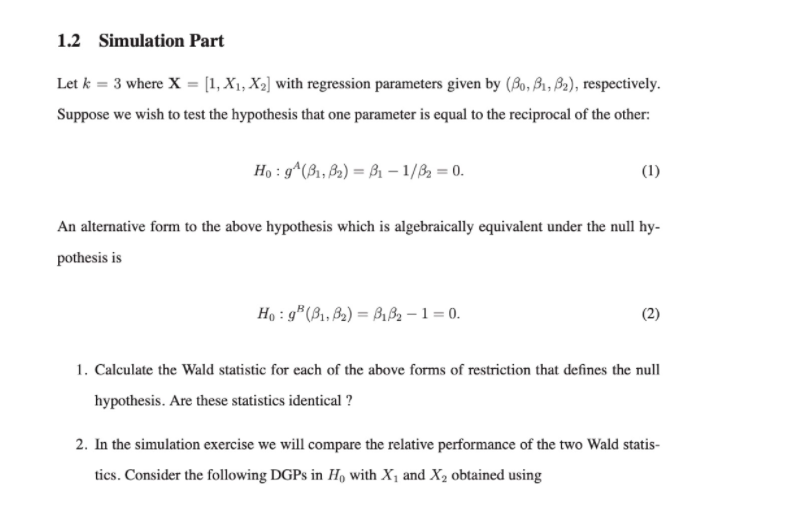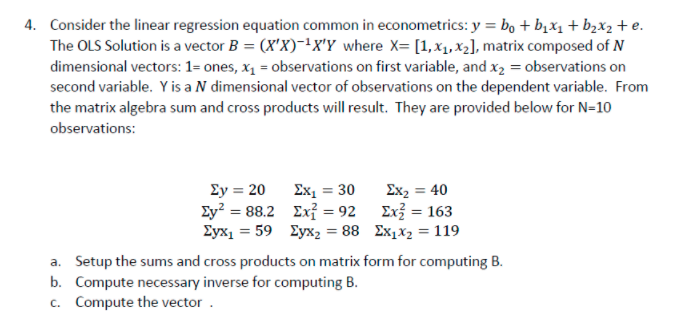,.. I need your input here please
Amanda's utility function is Leontief and given by Wa(Xarya) = min(xa. yal while Brenda's utility is linear and given by us(xb. )b) = XD + VD Their endowments are wa = (2,3) and wo = (4, 1). Show this economy in an Edgeworth Box Show the Individually Rational allocations and show in Edgeworth Box Find the Pareto Efficient allocations for this economy and show in the Edgeworth Box. Show the core of the economy. Find the Walrasian Equilibrium of the economy and show in your Edgeworth box. Prove directly that the First Welfare Theorem holds Does the Second Welfare Theorem hold for allocation ((3,3)a, (3,1),}? If so how?1. Consider a pure exchange economy.r with two goods. 1urine {I} and cheese (1;) and two con- sunierst A. and B. Let chemo he the numeraire good with price of 51. Consumer A's utilit:,r function is U'Aht', y} = I'yl while B's utility function is Winn} = Ilf'l'yaf'l'. as initial allocation is 31!] units of a: and 31.] units of y. B's initial allocation is it'll units of e and 20 units of y. {a} Put wine a: on the horizontal axis and cheese 1; on the vertical axis. Measure goods for consumer A from the lower left and goods for consumer B from the upper right. Marl: the initial allocation 1with the letter W. Draw the indifference curves for each person through this point. Calculate utility at this allocation for both consumers. Is the initial resource allocation consistent with Pareto efficiency? Explain. {h} Identify the contract curve of Pareto efcient allocations in this econo'lrljr and show this on your graph. {cl Find the competitive equilibrium prices and consumption for each type of consumer. Derive A's and B's demand functions (grossfhiarshallian). Calculate the equilibrium price of wine assuming price of cheese is 51, using 1illi'stlras" Law. {d} Verify that the First Fundamental Theorem of WEHEIE Economics holds, Consider a pure exchange economy with two individuals (Adam and Bob) and two goods (x and y). Their utility functions are given by UA(TA, yA) = JAYA and UB(TB, yB) 0.5 0.5 = "ByB Initially, Adam has 100 units of good x and Bob has 100 units of good y (a) Find the general equilibrium price ratio px/py and the general equilibrium allocation (their demand bundles in the equilibrium). Illustrate this general equilibrium allocation using Edgeworth box. (b) Find all Pareto efficient allocations in this economy, and illustrate all these Pareto efficient allocations in the Edgeworth box. (c) The first theorem of welfare economics states that the general equilibrium allocation is Pareto efficient. Is the equilibrium allocation you found in (a) efficient and why? Show transcribed image text(3) Consider an exchange economy with two consumers. Consumer A has utility function U(X1, 12) = $1 + 12 and endowment wA = (60, 10). Consumer B has utility function UB($1, 12) = 1142 and endowment w = (20, 30). (a) Draw wn Edgeworth box with the initial endowment and the correspond indifference curves through the endowment for consumer A and consumer B. (b) Note that at any Pareto efficient allocation where both consumers get strictly positive amounts of each good, their MRS must be the same. Use this observation to construct the contract curve. Are there Pareto effcient point where consumer A does not get a strictly positive allocation of both goods.? Draw the contract curve in the Edgeworth box. (c) Find the competitive equilibrium prices and competitive allocation. (d) Now consider an economy with 1000 consumers identical to consumer A and 1000 con- sumers identical to consumer B. That is each consumer A has the same initial endowment and utility functon, and similarly, each consumer B has the same endowment and utility function. Find a competitive equilibrium of the economy with 2000 consumers.2. In the simulation exercise we will compare the relative performance of the two Wald statis- tics. Consider the following DGPs in Ho with X, and X2 obtained using Xli 0.6 0.3 X1i-1 Eli + (61i, (2i, U.) IID ~ MVN (0, Is) (3) X 2i 0.3 0.6 X2i-1 X 10 and ~ MVN (0, 12) ; (4) X 20 Furthermore, consider the following sample sizes n = 20, 30, 50, 100, 500 and the values of regression parameters (Bo, B1, B2) : (1,10,0.1),(1,5,0.2). Report the empirical rejectionConsider the Linear Regression Model 1. For any X = x, let Y = x8 + U, where B E Rk. 2. X is exogenous. 3. The probability model is { f(u; 0) is a distribution on R : E,[U] = 0, Var, [U] = 02,0 > 0}. 4. Sampling model: {Y/},_, is an independent sample, sequentially generated using Y, = x;B+ Uji = 1, . ..,n, where the U, are a IID(0, 02). 1.1 Theoretical Part Let X be the n x k matrix of regressors, and let Y be the n x 1 vector of the dependent variable. 1. Compute BLS by minimizing (Y - XB)" (Y - XB), where B E RK. 2. Prove that BLS B, V(B, 0) ERk x R+ 3. Prove that vn (BLS - B) is asymptotically distributed as multivariate normal with zero mean, and report the asymptotic covariance matrix. Hint: The multivariate version of the\f1.2 Simulation Part Let k = 3 where X = [1, X1, X2] with regression parameters given by (8o, B1, 82), respectively. Suppose we wish to test the hypothesis that one parameter is equal to the reciprocal of the other: Ho : g" ( B1, B2) = B1 - 1/B2 = 0. (1) An alternative form to the above hypothesis which is algebraically equivalent under the null hy- pothesis is Ho : 95 (81, B2) = B1B2 - 1 = 0. (2) 1. Calculate the Wald statistic for each of the above forms of restriction that defines the null hypothesis. Are these statistics identical ? 2. In the simulation exercise we will compare the relative performance of the two Wald statis- tics. Consider the following DGPs in Ho with X, and X2 obtained using4. Consider the linear regression equation common in econometrics: y = bo + bix, + b2x2 +e. The OLS Solution is a vector B = (XX)-1XY where X= [1, X1, X2], matrix composed of N dimensional vectors: 1= ones, x, = observations on first variable, and X2 = observations on second variable. Y is a N dimensional vector of observations on the dependent variable. From the matrix algebra sum and cross products will result. They are provided below for N=10 observations: Ey = 20 Ex1 = 30 Ex, = 40 Ey? = 88.2 Ex = 92 Ex = 163 Eyx1 = 59 Zyx2 = 88 Ex1X2 = 119 a. Setup the sums and cross products on matrix form for computing B. b. Compute necessary inverse for computing B. c. Compute the vector
